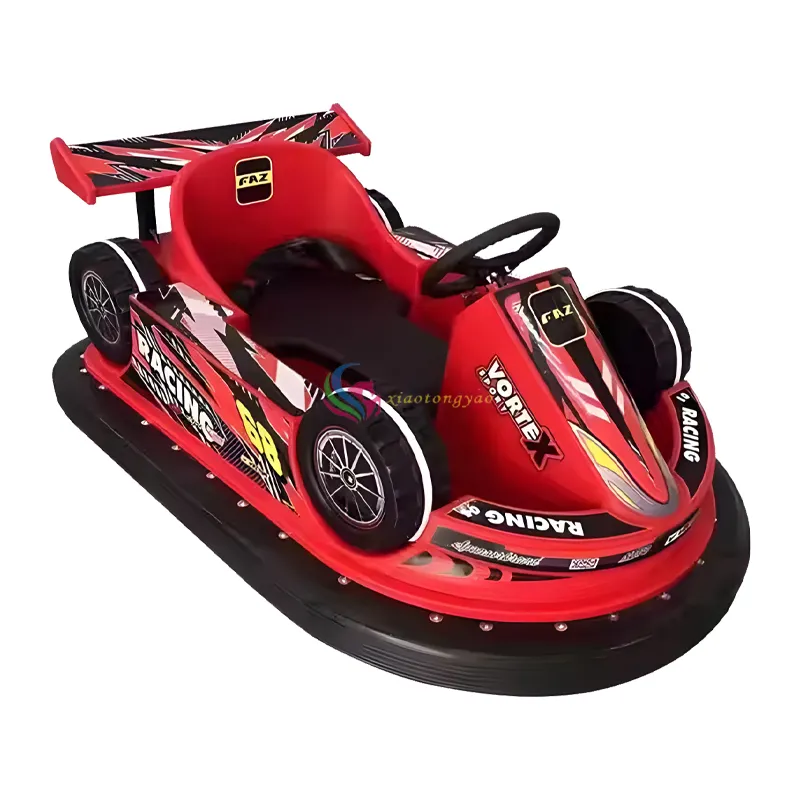인터랙티브 공원 어트랙션을 통해 마법 같은 추억 만들기
놀이공원의 세계는 해가 갈수록 획기적으로 변화해왔으며, 놀이자동차가 어린이 오락의 선두에 서 있습니다. 이러한 특수 제작된 차량들은 일반적인 공원 방문을 특별한 모험으로 바꾸어 아이들의 마음을 사로잡고 오래가는 추억을 만들어 냈습니다. 색색이 반짝이는 차량부터 범퍼카 테마가 있는 트랙 없는 차량까지, 이러한 인터랙티브 놀이기구는 현대적인 가족형 엔터테인먼트 공간에서 필수적인 요소로 자리 잡고 있습니다.
오늘날의 엔터테인먼트 카는 단순한 탑승 기구를 넘어서 스릴, 안전성, 교육적 가치가 결합된 완벽한 경험을 제공합니다. 움직임과 상호작용, 상상력을 자극하는 테마를 결합함으로써 이러한 어트랙션은 기존 놀이터 장비를 넘어선 몰입형 경험을 어린이들에게 제공합니다. 이러한 차량이 어린이의 즐거움과 발달에 미치는 영향으로 인해 전 세계 공원에서 빼놓을 수 없는 요소로 자리 잡고 있습니다.

공원 놀이기구에 대한 어린이들의 흥미 심리학
놀이와 움직임을 통한 발달
어린이들은 본능적으로 오락용 자동차 엔터테인먼트 카에 끌리는데, 이는 그들이 가지는 기본적인 발달 요구를 충족시키기 때문입니다. 이러한 차량을 운전하고 속도를 조절하며 경로를 탐색하는 행위는 운동 능력과 공간 인식 능력을 향상시키는 데 도움을 줍니다. 어린이가 엔터테인먼트 카를 타는 행위는 단순한 놀이를 넘어 중요한 조정 능력을 배우고 자신의 능력에 대한 자신감을 쌓는 과정이 됩니다.
이러한 놀이기구가 제공하는 감각 경험은 인지 발달에도 크게 기여합니다. 움직임, 효과음, 시각적 자극이 결합된 환경은 다양한 감각을 동시에 활용하는 풍부한 학습 공간을 만들어냅니다. 이러한 다감각적 몰입은 신경 경로의 발달과 학습 능력 향상에 매우 중요합니다.
사회적 상호작용과 감정적 성장
놀이용 자동차는 종종 아이들 간의 사회적 상호작용을 유도합니다. 함께 타거나 경쟁하는 상황 속에서 아이들은 차례를 지키는 것과 협동, 의사소통과 같은 중요한 사회적 기술을 배우게 됩니다. 함께 타는 경험은 형제자매나 친구들, 공원에서 새로 만난 친구들 사이에도 유대감을 형성해 줍니다.
정서적 이점 또한 매우 큽니다. 스스로 경로를 성공적으로 통과해 나가는 경험은 자신감을 키워주고, 감정 조절 능력을 기르는 데 도움이 됩니다. 오락 차량 라이드를 타는 것은 자존감과 독립성을 키워줍니다. 아이들이 조종법을 익히게 되면 성취감을 느끼게 되고, 이는 자신의 능력에 대한 자신감 증대로 이어집니다. 이러한 긍정적인 경험은 정서적 회복력과 새로운 시도에 대한 건강한 태도를 형성하는 데 기여합니다.
놀이자동차를 매력적으로 만드는 디자인 요소
시각적 매력과 테마
현대의 놀이자동차는 시각적 미학에 신경 써서 설계되었습니다. 화려한 색상, 흥미로운 테마, 캐릭터 디자인은 아이들의 상상력을 자극하며 즉각적인 감정적 연결을 만들어냅니다. 판타지 차량, 동물, 또는 인기 애니메이션 캐릭터 형태로 제작된 이 놀이기구들은 아이들을 자신만의 마법 같은 세계로 안내하는 몰입형 경험을 제공합니다.
테마는 외관뿐만 아니라 사운드 효과, 조명, 인터랙티브 요소까지 확장되며, 이 모든 것이 결합되어 완전한 감각 경험을 선사합니다. 이러한 디테일에 대한 집중적인 고려는 아이들의 흥미를 유지시키고, 여러 번 탑승하더라도 매번 새롭고 흥미진진한 느낌을 줍니다.
안전 기능 및 접근성
최신식 어트랙션 차량에는 어린 승객들에게 매력이 유지되도록 하면서도 고도화된 안전 기능이 적용되어 있습니다. 인체공학적 설계는 다양한 연령대에 맞는 편안한 착석을 보장하며, 자동 안전 시스템은 부모들에게 안심을 제공합니다. 안전성과 재미의 균형은 혁신적인 엔지니어링과 철저한 테스트를 통해 신중하게 유지되고 있습니다.
접근성 기능을 통해 이러한 놀이기구는 다양한 능력을 가진 어린이들이 함께 즐길 수 있도록 포용적인 설계가 적용되었습니다. 조절 가능한 조작 장치, 지지력 있는 좌석, 명확한 사용 설명은 더 많은 아이들이 독립적으로 즐길 수 있도록 합니다. 이러한 포용적 설계 접근 방식은 모든 어린 승객들에게 자신감을 심어줍니다.
인터랙티브 차량 어트랙션의 교육적 효과
경험을 통한 학습
놀이용 차량은 오락으로 포장된 다양한 교육적 기회를 제공합니다. 아이들은 운동량, 조향, 속도 조절과 관련된 체험을 하면서 기초 물리 개념을 배우게 됩니다. 이러한 실질적인 경험은 인과 관계에 대한 직관적인 이해를 돕습니다.
이러한 놀이기구의 인터랙티브한 특성은 문제 해결 능력 향상에도 기여합니다. 아이들은 방향, 속도, 타이밍과 관련된 빠른 결정을 내리며 몰입된 환경에서 비판적 사고 능력을 개발하게 됩니다. 이렇게 습득한 능력은 다른 성장 영역에도 전이되는 경향이 있습니다.
공간 인식 및 탐색 능력
놀이자동차 운전은 어린이들이 공간 인식과 이동 능력을 향상시키는 데 도움이 됩니다. 거리 판단, 움직임 예측, 다른 탑승자와 장애물과의 상대적 위치를 이해하게 되며, 이러한 공간 인지 능력은 아동 발달과 일상생활 전반에 있어 매우 소중합니다.
테마가 있는 환경을 탐색하는 경험은 또한 어린이들이 정신 지도를 구축하고 방향 감각을 향상시키는 데 도움이 됩니다. 이러한 공간 학습은 아이들이 놀이를 즐기는 자연스러운 과정에서 일어나며, 효과적인 교육적 오락의 형태가 됩니다.
공원 엔터테인먼트에서의 놀이 자동차의 미래
기술 혁신
새로운 기술이 통합되면서 놀이 자동차의 미래는 점점 더 역동적으로 변화하고 있습니다. 증강현실(AR) 기능이 혼합현실 경험을 창출하기 위해 도입되고 있으며, 스마트 센서는 보다 민감하고 개인화된 놀이 경험을 제공합니다. 이러한 기술적 발전은 인터랙티브 엔터테인먼트를 위한 새로운 가능성을 열어가고 있습니다.
환경에 대한 인식도 이러한 관광지의 미래를 형성하고 있습니다. 공원들은 전기 동력의 놀이차량과 지속 가능한 소재에 투자함으로써 아이들에게 환경 책임에 대해 가르치면서도 재미있는 요소를 유지하고 있습니다. 이러한 친환경 혁신은 오락이 중요한 가치와 조화를 이룰 수 있음을 보여줍니다.
향상된 상호작용성 및 개인화
향후 놀이차량은 디지털 통합을 통해 보다 다양한 맞춤형 경험을 제공할 것입니다. 터치스크린, 음성 인식, 개인 맞춤형 탑승 설정 등과 같은 상호작용 요소가 점점 더 보편화될 전망입니다. 이러한 기능을 통해 아이들은 매번 방문할 때마다 독특한 경험을 창출할 수 있어 장기적인 흥미와 몰입도를 유지할 수 있을 것입니다.
연결된 경험으로의 트렌드는 오락용 차량이 곧 모바일 앱 및 다른 디지털 플랫폼과 통합되어 공원 방문을 넘어서는 오락적 가치를 제공할 수 있음을 의미합니다. 이러한 디지털 통합은 실제 탑승 경험 이전과 이후에도 학습과 몰입의 기회를 창출합니다.
자주 묻는 질문
오락용 차량 탑승이 가장 적합한 연령대는 어느 정도인가요?
오락용 차량은 일반적으로 3~12세 아동을 대상으로 설계되며, 다양한 모델이 특정 연령대에 맞게 제작되었습니다. 많은 공원에서는 유아용 단순 탑승형부터 나이가 많은 어린이를 위한 보다 도전적인 경험까지 다양한 옵션을 제공합니다. 부모는 항상 각 어트랙션의 구체적인 키 및 연령 기준을 확인해야 합니다.
오락용 차량이 아동 발달에 어떤 기여를 하나요?
놀이용 자동차는 운동 기능, 공간 인식 능력, 의사결정 능력 및 사회적 상호작용을 개발하는 데 도움이 됩니다. 물리학, 인과 관계, 문제 해결 능력에 대한 실질적인 학습 경험을 제공하면서 아이들이 배우고 성장할 수 있는 흥미롭고 즐거운 환경을 조성합니다.
최신 놀이용 자동차는 유아에게 안전한가요?
네, 최신 놀이용 자동차는 충격 흡수 재질, 안전한 착용 장치 및 속도 조절 장치 등 포괄적인 안전 기능을 갖추고 설계되었습니다. 정기적인 유지보수와 엄격한 안전 프로토콜을 통해 적절한 감독 하에 어린이들이 안전하게 이러한 놀이기구를 즐길 수 있습니다.




